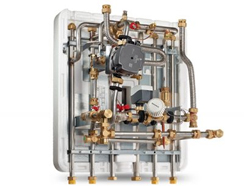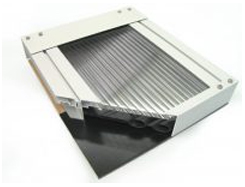The development towards “nearly zero energy buildings” (combined net consumption of space heat and domestic hot water < 40 kWh/m2), and the extension potential of district heating networks into less populated areas with reduced heat density has led the development of low temperature district heating (LT DH) systems. The main objectives of LT DH have been to reduce distribution heat losses and investment costs as well as ease the uptake of renewable and residual energy sources in the networks.
With the progressive reduction of district heating supply temperature, an increased number of heat production technologies can be incorporated to district heating systems, and technical limits to the incorporation of many RES and waste heat sources are reduced, allowing for the decarbonisation of the energy supply.
With the progressive reduction of district heating supply temperature, an increased number of heat production technologies can be incorporated to district heating systems
RELaTED has integrated present technologies into a new ULT DH concept, at distribution temperatures below commercially operative DH networks today.
The main innovation in RELaTED is the concept itself, where lower distribution temperatures are paired by a set of innovative technologies enabling for the rearrangement of DH networks into a collection of energy hubs, not only with local heat consumption, but also heat production, based on the following technologies:
- 3FS systems have upgraded the concept of consumer substations into elements where bi-directional heat flow is allowed between among three subsystems and the DH network with net metering & energy billing.
- Building integrated ST systems (BILTST).
- Heating applications (potentially district heating integrated District Heating Reversible Heat Pump, DHRHP).
- Reject heat re-use from cooling applications (potentially integrated via district heating integrated District Heating Reversible Heat Pump).
- BILTST systems have adapted traditional Solar Thermal systems for building integration into configurations compatible with DH, without further need of local heat storage, and the capacity to inject heat into the grid.
- DHRHP systems have adapted low-temperature DH operation with higher distribution temperatures within HVAC systems in buildings, particular technical applications of heat, and possible heat recovery from cooling applications.
District Heating Substation Technology
 District heating substations are devices whose main function is the connection of loads to DH networks in a standardized manner. Each DH operator specifies particular considerations regarding design & construction of substations in order to achieve homogeneous service levels within the network.
District heating substations are devices whose main function is the connection of loads to DH networks in a standardized manner. Each DH operator specifies particular considerations regarding design & construction of substations in order to achieve homogeneous service levels within the network.
Considering that medium-large DH networks commonly comprise thousands of consumers connected into the DH network, industrialized substations have been developed to guarantee common connection criteria with simplified engineering, installation and commissioning works.
In most common applications, substations comprise: a heat exchanger, regulation valves & controllers, heat meters, and auxiliary devices. In dual heating and cooling networks, substation configurations are commonly duplicated to serve heating and cooling services independently.
RELaTED has evolved the substation concept into an energy hub with multiple heat inputs and outputs. The objective is the 3FSs allow buildings to operate without local storage (with relevant cost and complexity reductions), and to integrate buildings as distributed heat sources in the DH network, allowing to balance instantaneous DH loads and productions.
RELaTED has evolved the substation concept into an energy hub with multiple heat inputs and outputs.
3FS systems have allowed for heat extraction from high temperature pipe (direct internal LT HVAC systems, DHW, electric boosters, DHRHP in heating mode); heat injection in the low temperature pipe (reject heat from HVAC & DHRHP in cooling mode, BILTST under low solar yield); heat injection in the high temperature pipe (BILTST under high solar yield), and internal heat transfer from BILTST to DHRHP or LT HVAC systems. All these functionalities have been achieved within one single substation, with net-metering capacity.
Heat Pump Technology
 Heat pumps are systems which deliver heat, based on a refrigerant circuit, and a heat source at lower temperature. These devices consume electricity in order “pump” heat to a higher temperature. The amount of required electricity is highly dependent on heat pump quality and the temperature difference between heat load and sources.
Heat pumps are systems which deliver heat, based on a refrigerant circuit, and a heat source at lower temperature. These devices consume electricity in order “pump” heat to a higher temperature. The amount of required electricity is highly dependent on heat pump quality and the temperature difference between heat load and sources.
The energy development of recent years has led to more efficient heat pumps. However, still the strong dependency of heat pump Coefficient of Performance (COP) towards ambient temperature still limits its application.
RELaTED has developed a district heating integrated District Heating Reversible Heat Pump (DHRHP) system, thought for its integration with ULT DH systems. In this concept, Heat pumps have been integrated with the DH networks as its primary heat source, at sensibly constant temperatures at 30-45ºC, depending on connection pipe of the primary loop. In this operational environment, heat pumps have operated at very high COP levels.
With possible connections to cooling distribution systems, the reversibility of heat pumps in the core of DHRHP systems has also provided infrastructure for heat injection in the DH network at no cost.
The reversibility of heat pumps in the core of heat pump systems has also provided infrastructure for heat injection in the DH network at no cost.
Overall, heat pumps within this environment has facilitated the reduction of temperature levels in DH networks ensuring proper heat delivery in cold winter periods, and high load temperatures for DHW systems under safe conditions, without fearing the proliferation of legionella.
Building Integrated Solar Thermal Systems Technology
Solar thermal (ST) systems in Europe are commonly composed by a set of ST collector panels which are connected to building HVAC by a liquid circuit which delivers its heat to a tank for thermal storage and partial de-coupling of ST heat production and heat use in the building.
RELaTED has integrated two ST collector as components of the Building Integrated Solar Thermal (BILTST) solar loop. These are differenced by their aesthetics and their geographic suitability:
Glazed ST collector system

Inaventa Solar collector
INAVENTA SOLAR has developed and produced an all-polymeric solar collector of modular design and flexible in dimensions for building integration. InaventaSolar has pioneer in the delivery of ST collectors fully constructed in polymeric structured sheets.
Due to mass production processes possible in polymer extrusion, InaventaSolar collectors represent an asset for cost-competitive production of solar heat. These collectors demonstrate aesthetic integration into the building envelope, overcoming existing installation barriers and reducing overall costs at the building site.
Unglazed ST collector system
Solar thermal façade system serves as the base for a joint development by Tecnalia and INNOMETAL of an all-metal industrialized envelope where the unglazed ST collector is integrated into an architectural envelope highly customizable in terms of aesthetics and integration into architectural projects.
The unglazed ST collector system is conceived as high-gain ST system, which, by operating at low collector temperature minimizes heat transfer to the surrounding air.

Solar thermal facade system in public Safety Headquarters, Bilbao (Spain).
RELaTED has developed a BILTST system, thought for its integration with ULT DH systems. The performance of ST collectors in this scheme has been substantially higher to traditional ST systems considering that:
- All excess heat has been injected into the DH network, without constraints related to the technical and economical optimization of local storage
- ST technologies has operated at low temperature levels with its intake connected to the return line of the DH network ~30ºC.
Depending on the output temperature of the BILTST system, its outlet has been connected to the DHRHP, High-temperature or low temperature DH pipe, to ensure maximal use of solar heat.
